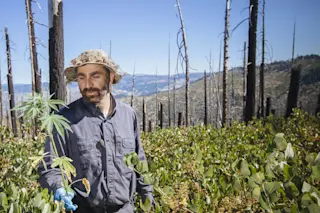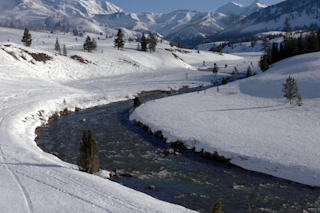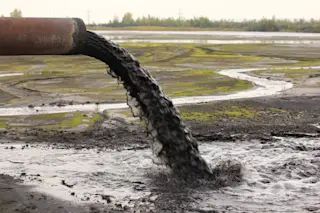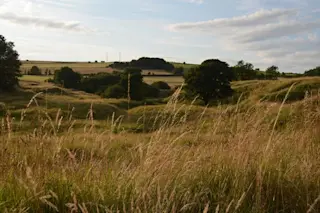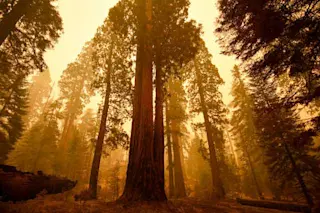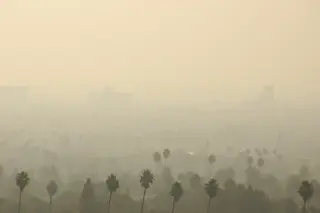On a hot August morning, Mourad Gabriel steps out of his pickup onto the gravel road that winds up the side of Rattlesnake Peak. Dark-bearded and muscular, the research ecologist sports a uniform of blue work clothes, sturdy boots and a floppy, Army-style camo hat. He straps on a pistol. “Just to let you know,” Gabriel says, sensitive to the impression the gun makes, “it’s public land, so I open-carry.”
Another 100-degree day is promised. Gabriel and his four field assistants are headed to work in California’s Plumas National Forest, a few hours’ drive from Lake Tahoe, at the northern terminus of the Sierra Nevada. The U.S. Forest Service (USFS) has enlisted Gabriel to assess the scars from rampant marijuana cultivation. Today’s field site: an illegal marijuana plantation known as the Rattlesnake Grow.
Gabriel doesn’t take chances because he’s been threatened personally. In 2014, someone poisoned his family dog with a pesticide that’s used at the grow sites. The intruder crept onto Gabriel’s property at night and scattered poisoned meat in his backyard. And last year during raids on plots elsewhere in California, two police dogs were stabbed by men fleeing the scene.
So whenever Gabriel enters a cultivation site with his research team — even one that’s been abandoned, as this one is — he always goes in first.
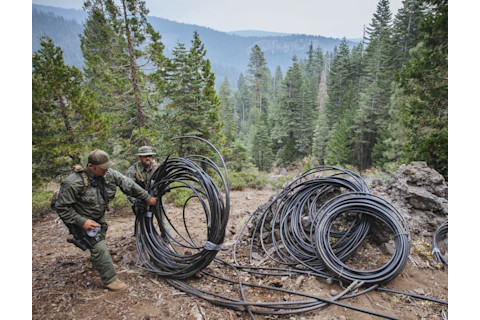
U.S. Forest Service officers collect coils of plastic pipe used to divert water from springs to marijuana plants at an illegal grow site on public lands. (Credit: Morgan Heim)
Morgan Heim
Most of the U.S. domestic marijuana supply is raised in California. Some pot is grown on private property for legal use by medical marijuana patients. These operations can be monitored, and with Californians having legalized recreational pot last November, the regulation is sure to tighten. But in popular pot-growing regions like Humboldt, Mendocino and Trinity counties — closer to the Northern California coast in the so-called Emerald Triangle — environmental regulation has been slow to catch up. Commandeering streams, growers divert the water into high-tech greenhouses, to the detriment of the aquatic life lower in the drainage, including the threatened coho salmon. Biologists for the California Department of Fish and Wildlife have shown that thirsty marijuana plantations can dry up water sources.
What’s more, the rest of the crop — the vast black-market portion — is planted on public or tribal lands by people who ignore the environmental consequences of their activity. When they’re captured, some turn out to be Mexican drug cartel workers, and others come from smaller independent groups. U.S. authorities concede that the great majority of these “trespass grows” are never detected. Even after sites are cleared, the shadowy growers may reclaim them the next year.
“The public doesn’t understand the industrial scale of this,” says wildlife biologist Craig Thompson.
But if you have heard anything about streams being polluted or animals and birds being poisoned by marijuana production, it’s almost certainly because of Gabriel, a soft-spoken scientist who now and then unleashes his inner Rambo.
After the Bust
Gabriel takes his team of biologists over the top of an open, sunbaked ridge and down the other side of the mountain. Immediately, burnt and toppled trunks of pine and fir and head-high tangles of wild lilac shrubs impede the way.
Ten years ago, the Moonlight Fire destroyed 65,000 acres of forest in the Plumas. The marijuana growers stole into the broad footprint left by the blaze in dozens of places. In the section we’re hiking, they cut trails and cleared a series of plots on a steep slope above a ravine. Then the trespassers dug out three springs and diverted their flow into half-inch black plastic piping, which they threaded through the cover of vegetation to their network of plots below. The waterlines emptied into tarp-sealed pits that could store hundreds of gallons of water. Having started thousands of marijuana seedlings in plastic cups, the growers planted them among the shrubs throughout the plots. Each bright green plant was irrigated via drip lines, some triggered by a battery-powered timer. Although the mountainside faced north and east, light was no problem. Where it used to be blocked by trees, the strong California sun now slathered the crop.
Gabriel was with the rangers and deputies when they busted the site in 2015 and uprooted more than 16,000 plants. Judging by bags left around the site back then, he suspects at least 4,000 pounds of potent fertilizer were used. He also recorded several empty containers of a concentrated organophosphate insecticide — a lethal nerve poison that’s toxic to wildlife.
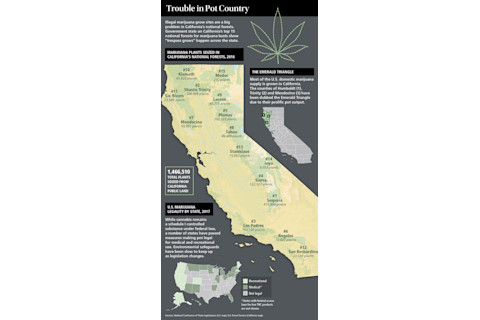
(Credit: Maps, Alison Mackey/Discover; pot leaf, Martial Red/Shutterstock)
Maps, Alison Mackey/Discover; pot leaf, Martial Red/Shutterstock
Gabriel’s non-profit organization, Integral Ecology Research Center (IERC), was hired to assess the damage to water sources, soils and sensitive plants and animals. They also inventoried toxic waste, piping, camp materials and trash. Now it’s up to the Forest Service to decide how to repair the damage. Gabriel, enlisting local volunteer groups, will assist with the cleanup, too. The service he offers is soup-to-nuts.
“He’s passionate. He’s a character,” says USFS’s Thompson, who collaborates with Gabriel on research. “He has continued to shine a light on the issue, though it’s still under the radar.”
Connecting the Dots
The first glimmer of impacts to wildlife came to Gabriel from fishers. A fisher — a type of weasel whose body is about the size of a housecat’s — is a denizen of deep woods. It has a wide face and long furry tail, and it can run up and down trees like the woodrats and squirrels it hunts. Fishers have never been overly abundant in the mountains of the West Coast, and their population plummeted after a century of logging and trapping. In the 21st century, biologists have tried to restore the Pacific fisher by reintroducing young animals and tracking them with radio collars. But the fishers’ expansion has been slow because they have been dying more rapidly than researchers expected.
Gabriel joined the fisher reintroduction project in 2009. At the time, he was completing his Ph.D. at the University of California, Davis. He credits an uncle for interesting him in the outdoors. The uncle was also a taxidermist; hence, young Mourad developed an interest in the interiors of animals. In high school, a vocational aptitude test suggested that he could be a game warden, park ranger or biologist. As an undergrad at Humboldt State University, he took courses supporting all three. Gabriel met his future wife, Greta Wengert, while they were both studying wildlife biology in college. After marrying, the two founded IERC in Blue Lake, Calif.

Craig Thompson, a USFS biologist, drops a water filter into a High Sierra stream near a marijuana grow site. Tests have turned up pesticides and fertilizers coming from the grows. (Credit: Morgan Heim)
Morgan Heim
Gabriel’s work for the fisher reintroduction project was lab-based. He conducted necropsies of dead animals that Thompson’s field researchers had picked up. Examining a fisher carcass one day, Gabriel found that its organs had turned to mush. The fisher had been poisoned by a compound that blocks clotting and prompts unchecked internal bleeding, a so-called second-generation anticoagulant rodenticide (AR). D-CON, commonly used against mice and rats, is a familiar brand of AR. But how did a forest carnivore absorb a pesticide typically used around farms and houses?
Gabriel remembers wondering if this one fisher was an outlier. “So we went back to the archival liver tissue,” he says. When he inspected frozen specimens and collected additional carcasses from colleagues, Gabriel discovered that rodenticides had, if not killed, then at least tainted 85 percent of expired fishers.
“It took a while to connect the dots,” he says. From his field experience he was familiar with illegal pot grows, which had plagued the backcountry terrain for 20 years or more. “We’ve all run into it. We’ve been trained,” Gabriel says. “If you come upon a site, you do a 180 and walk away.”
Mounds of Pesticide
Law enforcement officers from different agencies asked him if rat bait from grow sites might be the culprit. It made sense; woodrats and squirrels would gnaw the marijuana plants.
If the growers scattered AR and the rodents were sapped by internal bleeding, they would become easier prey for fishers. Bioaccumulation, as the process is known, would pass the rodenticide up the food chain, where concentrations increase. The fishers in turn might have become prey for bobcats and mountain lions.
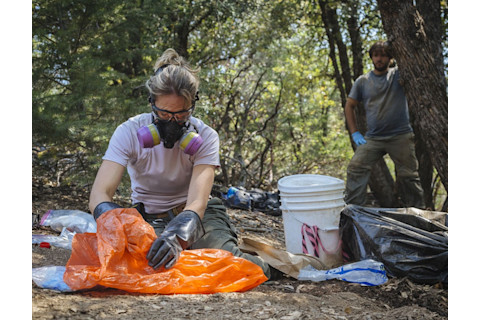
Wildlife biologist Greta Wengert carefully handles a suspected neurotoxin found in a Gatorade bottle. (Credit: Morgan Heim)
Morgan Heim
Raids turned up empty bags of AR and sometimes even mounds of the pesticide. To test their hypothesis about bioaccumulation, Thompson, Gabriel and state toxicologists tried to tie the levels of AR exposure in fishers with the locations of grow sites found by law enforcement.
The researchers analyzed 46 female fishers that died over five years. Their results showed that the animals that lived longest had the least rodenticide in their livers and the fewest grow sites within their home ranges. Conversely, animals with roughly four or more grow sites nearby died the soonest.
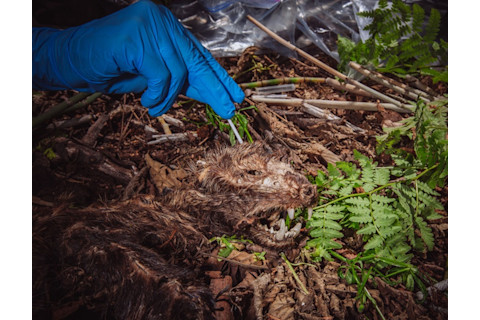
Researchers examine a Pacific fisher carcass. The animals are struggling in part due to rat poison used by illegal marijuana growers. (Credit: Morgan Heim)
Morgan Heim
In a 2015 paper in the journal PLoS ONE, the researchers stepped back and examined all the causes of mortality in their collared fishers. Predation accounted for 70 percent of the deaths, disease an additional 16 percent, and poisoning, which until lately hadn’t been considered, 10 percent. The new factor might explain why fishers weren’t rebounding as fast as they might be. Pesticides might be the major factor in most of the deaths, even those not poisoned outright. “You can argue that the animals that are affected by rodenticide are weaker,” Thompson says, “and that the predation rates on them, as I suspect, are higher.”
Sounding the Siren
In a parallel case, rodenticides have worked their way into some of California’s northern spotted owls, a threatened species. The owls also eat tainted rodents near grow sites. The evidence here is less direct, and depends on analyses of a competing species, the barred owl. For decades, barred owls from Eastern states have been invading the breeding territory of the northern spotted owl in California, Oregon and Washington. Already on the ropes from the logging of old-growth woods, spotted owls were disappearing, and so biologists tried a desperate measure: shooting barred owls.
At the Hoopa Valley Indian Reservation in Humboldt County, forestry biologist Mark Higley, who has helped with the fisher project, also takes part in the culling of barred owls. Higley says he and his staff have had run-ins with illegal growers, “taking risks we shouldn’t take.”

(Credits, from top: NOAA/NMFS/Southwest Fisheries Science Center Salmon Ecology Team; Morgan Heim; J. Mark Higley/Hoopa Tribal Forestry)
After Gabriel’s breakthrough with AR and fishers, Higley sent him liver samples of more than 155 barred owls that had been collected at Hoopa. More than half were positive for rodenticide. Gabriel also had positive results from two spotted owls that were hit by cars. Since spotted owls are endangered, Higley and Gabriel use barred owls as a surrogate — their dietary habits are similar — and infer that up to half of spotted owls near grow sites might be exposed to rodenticide. Now Thompson is looking for other examples of bioaccumulation. He’s testing mountain lion scat for rat poison and pesticides.
Only Gabriel, Thompson and a handful of other biologists are investigating the ecological effects of toxins from the trespass grows. The funding opportunities are scant, and the fieldwork is hard and potentially dangerous. Although growers who have been surprised at their plots haven’t hurt anybody — usually they just run away — sometimes shots are fired.
Adding to the frustration, many important questions are nearly impossible to answer. At what levels do agricultural chemicals and rodenticide interfere with fishers’ reproduction? How much poison does it take to weaken an animal enough that it becomes easy prey for fishers and bobcats? Wildlife toxicology’s pitfall is that lab experiments can’t be performed on wild populations, let alone on sensitive and rare species.
“You have these snippets of field-based evidence,” Gabriel says. “Maybe you could do a liver biopsy on a captive fisher, but it would cause bleeding, and if an anticoagulant were affecting the animal, [the test] could push it over the edge. I’ll leave that work to someone else.” His role, as he sees it, is sounding the siren. “The problem is getting worse,” he says, frustrated. “Who’s documenting this?”
The Unseen Grower
Amid the lilac shrubs, pungent with pollen, marks of the Rattlesnake Grow aren’t immediately obvious. Soon the paths and waterlines of the growers can be spotted, and then other items like fertilizer bags, heavy-duty plant shears and matted clothing, which the wilderness is swallowing up.
As Gabriel investigates a stream angling toward the ravine, the four techs split into pairs. Two young field biologists push off in opposite directions, using their GPS trackers to measure plot boundaries.
The slanting plot, still faintly pocked with bare spots where the marijuana grew, is about 50 yards wide and 100 yards long. They crisscross the area with cans of spray paint, tagging empty bags of chemicals as they count them. When they take a break, they huddle in the shade thrown by the charred trees.
Walking on a diagonal line across the site, the biologists collect at least five samples of soil in plastic bags. The samples will be tested for various pesticides. Five samples for 1,500 square yards might not seem like much. “That’s all we can get funded for,” says Gabriel, who has rejoined the others. He reports spotting boot tracks. “I think they came back and took the tent and sleeping bags, probably sometime last spring.”
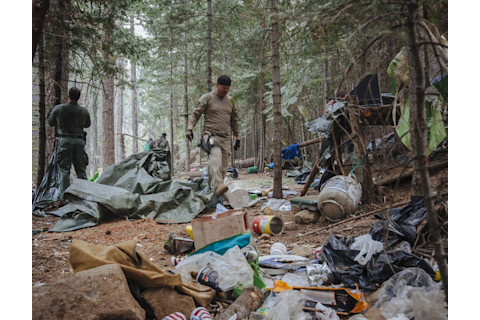
Growers often squat in primitive camps on public lands, leaving their mess to the Forest Service after harvest time. (Credit: Morgan Heim)
Morgan Heim
Of all the species Gabriel studies, the human animal — the unseen grower — is the hardest for him to figure out. “I’ve visited between 100 and 200 grow sites,” he says, leaning against a fallen tree. He wonders, why would growers plant so high up on this ridge with limited water?
“We saw a different approach last week,” Gabriel says. “Just 60 meters from a paved road they were growing 5,000 plants. Maybe one criminal organization decides, ‘We’ll go deep in the wilderness,’ and another, ‘Let’s put it by the road.’ You’re trading easier access for greater risk.”
He sees each site as a piece of a larger puzzle. If researchers could better understand the selection process, it might be possible to better handle these trespass grows.
Later, over a beer in his motel room, Gabriel says, “There’s no way I can do this physically 15 or 20 years from now.” He figures he’s got eight more years, after which he hopes the field will be big enough for him to exit and do something else, leaving others to carry on the research. He’s trying to spur other biologists to study illegal grows too. He wants to track the long-term effects of the chemicals by incorporating specialties like hydrology and soil science.
“As an ecologist, I love working on species of conservation concern,” he says. “I want a stable population of fishers and owls. I want basic research and applied management. Not science just for the sake of science but science as a solution.”
Jeff Wheelwright, a contributing editor at Discover, has written two books on environmental science and has reported on wildlife issues for four decades.
[This article originally appeared in print as "High Consequences."]


